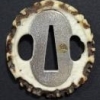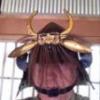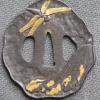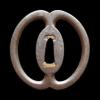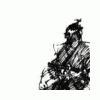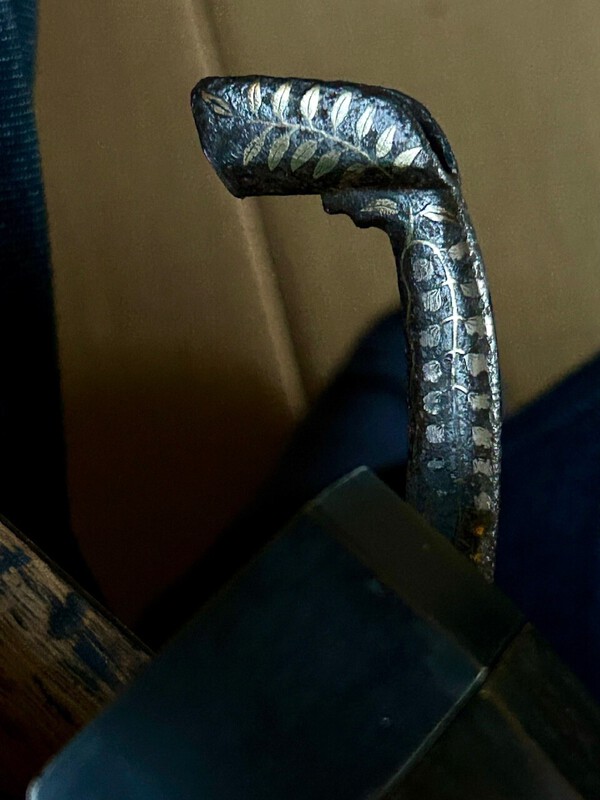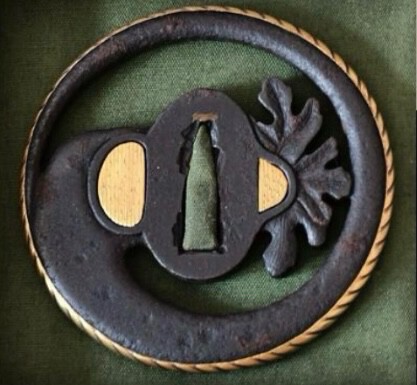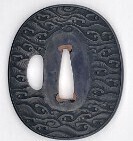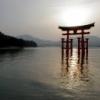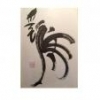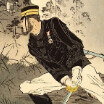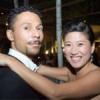Leaderboard
Popular Content
Showing content with the highest reputation on 04/05/2025 in all areas
-
Here are my 2 swords. I think they both deserve a spot on this thread. Both are flea market/dry goods store finds but both were made by renown smiths. The Shin gunto was made by Ishido Teruhide and the Kai Gunto was made by Miyaguchi Kunimori. I already posted the Kai gunto here back in 2021 but the Shin gunto was acquired recently. I was going to ask you guys for translation but i found it out myself here. Anyway, here they are.5 points
-
Hello, I had the opportunity to see this tsuba in hand. For me it is not cast. Ok mei is crude, and it is not a great/tight iron quality, but for me it is forged, and have a nice design. IMHO, all posts where photos were circled in red or blue show legits doubts when you just see photos. I looked at the hole in the square, seppa dai, bamboo nodes, etc... for me nothing indicate it is cast. Of course, it is just an opinion and I could be wrong4 points
-
Smith is Kanenao and date is Showa 16 year 2 month day (a day in February of 1941) Grey4 points
-
A very famous scene that appears throughout the Edo Period in Tosogu pieces Justyn! You see this motif a lot on fuchigashira and on the occasional tsuba as well. Here is an example from my collection that I acquired not too long ago signed "Hamano Noriyoshi". You should hopefully recognise similarities from your own such as the bow in the mouth of the riding samurai on your tsuba! The samurai should be Kajiwara Kagesue riding Minamoto no Yoritomo's horse. Here is a woodblock for comparison:4 points
-
Hi Jiri and welcome. https://www.samuraimuseum.jp/shop/product/tsuba-watch-0036/ I don't think it is Christian - certainly not "Hidden Christian" that is for sure. Nice silver fukurin which dresses up an earlier guard - I don't think Tempo/tembo had any other forms of decoration when they were first made - but fashions change I suggest this from the download section. It is very informative.3 points
-
But please don't fall for this "Hamano" mass production! https://www.ebay.com.au/itm/286451162808 or https://www.ebay.com.au/itm/286451162659 or https://www.ebay.com.au/itm/365486205999 or https://www.ebay.com.au/itm/387824172249 well I guess you get the idea! I don't even trust this one with papers - https://www.seiyudo.com/tu-050320.htm I have seen half a dozen with iroe that look just as good at first glance. https://www.bonhams.com/auction/18980/lot/15/a-bakumatsu-shakudo-tsuba-late-19thearly-20th-century/3 points
-
吉岡豊前 – Yoshioka Buzen 麒麟縁頭 – Kirin (Qilin) fuchigashira 赤銅魚子地 – Shakudo, nanakoji, 高彫 - Takabori 銘 吉岡豊前 – Mei Yoshioka Buzen 名作也 – Great work --- Seems to be added later. 昭和壬子秋 – Showa Mizunoe-Ne (1972), autumn 寒山誌 – Kanzan wrote.3 points
-
2 points
-
The short answer to your question is yes. But that assumes there was only one smith using that name at the time, and that we absolutely know that as a fact, which often we don’t. For example, we now know of blades signed by a very young Jirozaemon Katsumitsu in 1489 which is much earlier than his stated work period listed in Fujishiro and other sources. So, if you have a blade signed simply Bishu no Kuni Ju Osafune Katsumitsu and dated 1489, you would probably think it was the work of the main master of the time, Jirozaemon’s father, Ukyo no Suke Katsumitsu, but you might be wrong. There are periods, especially in the later Muromachi, when smithing families ran large studios with slews of smiths using the same “generic” signature. In this, the Sukesadas and Kiyomitsus had some of the largest and most prolific production houses of their day to meet the demand for both mass produced and special order pieces. And lots of their work includes these inferior pieces, leading many to dismiss Sue Bizen as junk. This is why hardcore Sue Bizen collectors focus on and pay more for blades with Zokumyo Mei, which I will roughly translate as “full signatures” using their common art names, like Ukyo no Suke Katsumitsu, or Gorozaemon no Jo Kiyomitsu. These tend to be a key determining factor separating their top-of-the-line special order blades from early export pieces to China at the turn of the 16th century and later mass production “bundle swords” for rank and file troops during the height of the Sengoku Jidai. They are also a key factor in determining price. Fully signed and dated pieces are fewer in number, of higher quality, and thus the premium. (If I recall correctly, I remember reading somewhere that the Kiyomitsu line were not prodigious users of Zokuyomei but you should double check that.) So, if Markus has only one smith working at the time, chances are you are probably right that that’s the smith who made your blade, but not necessarily so. That is why it is so important to study the working periods and nuances of these smiths so you might be able to recognize the hand behind the generic work. To do that you must study Zokumyo Mei pieces carefully where you can find them. In Honma sensei’s Kanto Hibi Sho, (translations are available from Markus) you will see him parse the work of these smiths carefully, explaining why thinks a generic Sue Bizen blade might be the work of a particular smith in a studio. Like everything thing else in this crazy hobby, it takes time, book study and exposure to as many blades as you can find.2 points
-
When you start out you tend to prioritise motif/design/theme more than quality. It takes at least about a year of deep involvement in the hobby before you start to develop the eye for quality. Honestly I am still developing my own. Your collection also starts off kind of random to start (at least, mine did). I recommend starting off just aiming to buy real authentic Edo Period pieces with designs you personally like, for reasonable prices. Aim to keep your purchases below 500-600 AUD at maximum when you start out and just focus on learning to discern real Edo pieces from casts or reproductions. As time goes on you'll begin to get a sense for quality of craftmanship as well as materials and then you can start to save up for more expensive pieces. You can get some very nice quality pieces for that price, believe it or not. The fuchigashira in my profile picture is one of my best pieces and I picked it up in an auction on Jauce for about $550 AUD. I've only very recently started spending more than that on higher quality pieces now that I have developed my eye a bit. I also recommend using Jauce or a similar service to access Japanese Yahoo auctions as you can find great pieces there, often for better prices than direct from dealers or from Ebay. Keep using and reading the forum frequently as it is a great source of knowledge and once you figure out what sort of style you like (which may take a while) start doing some online research and compiling examples of quality work in that style or from that school. Building something like a digital archive of pieces will help. If you read the forum consistently, train your eye by looking through listings regularly and most of all are patient, you'll begin to develop a decent eye for quality and an ability to discern reasonable price ranges within a year.2 points
-
Even IF the Mei was genuine I still wouldn’t pay anywhere near the asking price. Focus on the quality of the work…..it lacks finesse.2 points
-
I still think it was made in Japan and likely is an authentic mid-late Edo Period piece. I don't think the quality is bad, but I also don't think it's spectacular. As Colin says, vastly overpriced. I wouldn't pay more than maybe 1/6th the asking price unless I was absolutely 100% certain the mei was authentic. When you compare it to the other examples I posted, I'm doubtful.2 points
-
I will put my hand up and say I bought one years ago but I only paid $12 which is still more than they are worth - but a cheap enough paperweight price! Don't feel sorry for me - - I have had hours of fun bitching about the bloody things and trying to shy people away from them! One behind glass on Jauce https://www.jauce.com/auction/c1096574189 https://www.jauce.com/auction/e451593597 This could go over on the "Share the most cringeworthy tsuba you have seen" thread https://www.nipponto.co.jp/swords10/KY337224.htm Not just the tsuba but the file and scruff marks on the blade they are selling!!2 points
-
2 points
-
I am sorry for the loss of your friend, Steve, as well as to the others who knew, loved, and cared for him.2 points
-
Hi Dylan, It’s a a Chinese reproduction. Similar examples can be found on eBay being sold from China. These are very common. Here’s a linked thread in the military section of the forum that details other examples of fakes: Conway2 points
-
2 points
-
2 points
-
1 point
-
Thought this was worth including as it illustrates what I was saying. https://web.archive.org/web/20230607163725/http://touken-matsumoto.jp/en/product/shousai/WA-05821 point
-
1 point
-
1 point
-
I recently picked up this set, and went down a bit of a rabbit hole trying to get a full picture of the details depicted. I thought that I would share what I have found. There are other posts referencing this motif, but I didn’t find one that gave details… Happy to have any other details that I have missed, and shares from anyone else who has tosogu on the same theme. The set The tsuba is almost circular. It is shakudō, with a nanako ground, and chiseled in relief with details in gold. The tsuba shows the race across the Uji River. The fuchi-kashira show samurai at a Shinto shrine. The Race Across the Uji River (1180) This set has the depiction of a scene from the 14th-century military epic “The Tale of the Heike” (Heike monogatari). In the telling of this part of the story the Taira army were chasing a rebel army that had been raised by Prince Mochihito. The two armies met at the site of a bridge across the Uji river. The following confrontation became known as the First Battle of Uji (1180). The rebels stripped the bridge back to its bare bones (see the top left of the tsuba) forcing the armies to confront each other in an archery duel, which tended to favour the rebels as they had warrior monks on their side who used powerful bows that could penetrate the wooden shields used at the time. The battle wore on until sunset with the broken bridge as a chokepoint leading to stalemate. As the sun set, a retainer on the Taira side suggested that they should try to ford the river or go around to find another route. The river was swollen by heavy rains, but Sasaki Takatsuna and Kajiwara Kagesue decided to lead a contingent of 300 samurai across the river to engage with the enemy on land. The two of them rushed to get across the river first with Sasaki Takatsuna cheating a little by calling out to his rival that his mount’s saddle girth was loose, allowing him to ride ahead while Kajiwara Kagesue checked to see if his saddle was secure. On the tsuba we can see Sasaki Takatsuna and Kajiwara Kagesue, racing to get across the river. The position and depiction of Kajiwara Kagesue on the right is very closely mirrored by this diptych held by the Walters Art Museum. We can see Kajiwara Kagesue holding his bowstring in his mouth in the same way, and his horse is twisting to his left too. Holding the bowstring in his mouth seems to be a common trait in depictions of Kajiwara Kagesue as he crosses the river. The reverse of the tsuba has a group of three samurai on the opposite bank of the river, with the bridge in the upper right. They are presumably the opposing army, and seem to be gesturing to their enemies across the river. It’s hard to say exactly what action from the story is being depicted on the fuchi-kashira. The kashira shows a samurai at a shrine which could be related to the fact that Prince Mochihito had stayed at the Mii-dera temple before moving his forces to Uji. The fuchi shows samurai (possibly the main characters) preparing or resting next to a tied up horse. This battle seems to have been a popular moment of the story for depiction on tosogu and other art forms, with examples such as those above (and many others that have been shared on this board in the past), and this kozuka in the MFA Boston also showing the beginning of the race across the river. This screen held at the Met shows another view of the start of the race to cross the river, with the broken bridge in the background. Sources: https://www.metmuseum.org/art/collection/search/78537 https://art.thewalters.org/object/95.181/ https://en.wikipedia.org/wiki/Battle_of_Uji_(1180)1 point
-
I don’t like to talk about expense… Personally, while I haven’t really fixed on a preferred style I am increasingly in love with good nanako, and I love wave patterns, so this set hit all my weak points.1 point
-
Thanks Justyn, I must confess it is currently the single most expensive piece I have in my collection and I was happy to have an excuse to share it here! I have started to gravitate toward the Hamano style and am a big fan of contrast pieces. The contrast between shibuichi and gold is something I find quite appealing...1 point
-
Thanks Jake for the advice. It is a very helful community and they have helped my in my journey.1 point
-
Hi, Item No. 194 in the 'A Series of fittings ' thread ( pinned above ) will give a comparison. Regards1 point
-
The design is kind of interesting. The oni peering through the bars is innovative so I understand where the sentiment comes from, but $3600 USD is crazy! $600 USD is already probably more than I'd pay unless it came with certification.1 point
-
This set is beautiful. The detail is amazing, and I love how the creator has fitted the action into such a confined space.1 point
-
Thanks, and a great painting too. I hadn’t considered that holding the string in your mouth might be an extra-safe way to hold onto it. I had the vision of the bow bouncing up and down smacking him in the chin over and over again, but if he’s clinching it tight to the body and just controlling it with his mouth it makes a certain amount of sense…1 point
-
The nakago, the sugata, the length tends to gendai, but without signature i don't think you or we come closer to a result. Only a shinsa in Japan may help, or you can bring it to Utrecht to let some experts have a look on it: https://www.japanartfair.com/program/1 point
-
My opinion is it is likely an authentic tsuba. It looks like later Edo work (as the listing says, 1750's onward seems plausible). Quality is good (although price tag isn't cheap!) With regard to the tagane punch marks in the nakago-ana, my guess is that this has been inserted for beautification as a throwback to older styles. I don't think it is major cause to doubt the periodisation in and of itself. I think the biggest question for me is whether or not the mei on this tsuba is authentic or gimei, because I wouldn't even dream of paying the price I see listed on this thing unless it was a style + artist I was big on and I was absolutely 1,000% certain both the tsuba and the mei were authentic. The mei appears to be referring to Sugiura Issando Nagaharu Jo-i, an artist active in the 1760's who often signed "Jo-i" or "Issando Joi". From a preliminary search about this particular artist gimei pieces are quite common so I would be trying to find verifiably authentic pieces and making some very close comparisons of both mei and style before purchasing. One other concern is something about the linework in the tree on the Ura seems kind of modern to me and gives off a bit of a Meiji Period vibe. That said, I've seen marks like those underneath the tree in authenticated Hamano Shozui works from the 1750's so I still think 1750's is plausible. Some other pieces purportedly by the same artist for comparison: TLDR; Probably a real tsuba but might be gimei. Check style and signature extra carefully before buying. For me, I'd be wary just because of the price.1 point
-
The design is reasonably common, The practice of bean-throwing during Setsubun originated from a legend in the 10th century, during the reign of Emperor Uda, that a monk on Mt. Kurama escaped misfortune by blinding oni with roasted beans. The Japanese word for bean, 豆, is pronounced mame, which can be written as 'devil's eye' (魔目), and some believe that the pronunciation is similar to that of mametsu (魔滅), meaning 'to destroy the devil', which is why people began throwing beans during Setsubun. I am a little worried about the tagane-ato marks in the nakago-ana - - have they shifted any metal or are they just for show? https://www.slam.org/search/423%3A1949/ Perhaps Steven King can show some more similar designs, he has an example himself. Going on some other stock from the same seller - https://www.trocadero.com/stores/ConservatoireSakura/items/1465170/Iron-tsuba-Soten-style-gold-inlay I know this one is mass produced and not worth anywhere near the money they are asking!1 point
-
True, their photographs are clear but very dark. I have had the same thought hahaha1 point
-
The description is right. One can argue if iyozane or wide kozane, but that is insignificant, I think.1 point
-
No "serial numbers" on these. Just assembly numbers to keep all the parts together. So you can ignore that aspect.1 point
-
Lovely examples, Justyn, and great background information. With his horse struggling to turn away, I can guess that Kagesue needed both hands and all his strength to pull back on the reins. Interestingly in your example he has both arms right through the bow, doubling the safety net on it. You would not want to drop your bow in the river, and the mouth is a useful third hand! https://www.yamada-shoten.com/i_item/2023/02/141840.jpg1 point
-
As a start, here is the website of a swordsmith who takes orders, allows on-site visits, and has some information in English. https://www.hiratatantoujou.com/1 point
-
1 point
-
1 point
-
Hi Damon, be aware that this tsuba is doubtful to be a genuine Nagatsune Minamoto piece and is most likely gimei. In general the majority of pieces floating around out there with this mei are gimei pieces. Here is an authentic Ichinomiya/Minamoto Nagatsune tsuba. The quality should be apparent at a glance... I myself have a fuchi signed "Echizen Daijo Minamoto Nagatsune" in my collection though it too is likely gimei...1 point
-
1 point
-
1 point
-
1 point
-
At a glance, appears to set by Yoshioka Buzen (signed) and affirmed by Sato Kanzan.1 point
-
Looks Chinese... and by "Chinese" I am not implying modern fake. I scanned through all three volumes of Jan Culbertson's Chinese Swords and could not find a match though. Hopefully you can get more pictures @Bruce Pennington Conway1 point
-
There are a few more Tanuki in the Chōsen Gafu book - One looks like a Kashira design you will have to look out for? https://www.metmuseum.org/art/collection/search/24642 I also did a cleaned up copy of the book 154 pages of tosogu designs. https://www.amazon.com.au/Album-Designs-Metal-Carving-Chōsen/dp/1034179020 - Amazon and others want way too much, I can get soft cover copies for around $401 point
-
正宗二十代孫 – Masamune’s 20th generation descendant 相州住綱廣 – Soshu ju Tsunahiro Might be this smith? 日本刀 短刀 正宗二十代孫 相州住綱広 (十三代)|日本刀 刀剣販売 e-sword1 point
-
Masamune X Dai Mago 正宗 代孫 SoShu Ju Tsunahiro 相州住綱廣 (Still working on this. Hard to make out 'X', the generation number.)1 point
-
Less is often more when it comes to restoration of Japanese sword fittings that are many hundreds of years old. This needs to be remembered especially by all collectors, not just the novice collectors. I have read his article a few years ago in the JSSUS Newsletter republished shortly after his death. I was friends with Arnold Frenzel during the last few years of his long life. I remember sitting and talking to him about tsuba at table holders' dinner at the old Tampa show. I remember him later talking about recommending me to Nick to join the KTK. This was on the top floor of the Tampa Airport Marriot Hotel, and the room would rotate while you ate showing a panoramic view of the airfield. I also fondly remember the gourmet food and drinks as well at the dinner.1 point
This leaderboard is set to Johannesburg/GMT+02:00

.thumb.png.4c5df79fec171b2dc4a23af38e280a4d.png)
